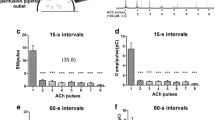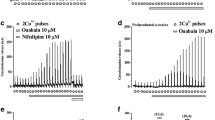Abstract
We have examined whether activation of protein kinase C by phorbol esters decreases the responsiveness of rat and rabbit mandibular, and rat lacrimal, acinar cells to muscarinic stimulation. Intracellular free calcium concentration ([Ca2+]i) was measured in isolated single acini and cell clusters by fura-2 microspectrofluorimetry. Accumulation of inositol phosphates was measured in acinar cell suspensions. All three cell types showed very similar changes in [Ca2+]i in response to acetylcholine (ACh), although mobilization of Ca2+ required somewhat higher ACh concentrations in rat lacrimal acinar cells than in mandibular acinar cells. There was no evidence for different dose dependencies of the peak and plateau phases of the [Ca2+]i response. The ACh-evoked [Ca2+]i increase in rabbit mandibular acinar cells exhibited desensitization, since it declined in magnitude when cells were stimulated repeatedly with a maximal dose of agonist. The phorbol ester 12-O-tetradecanoylphorbo-l13-acetate (TPA) rapidly and irreversibly decreased the ACh-evoked [Ca2+]i signals in rat lacrimal acinar cells and reduced ACh-stimulated inositol phosphate accumulation. This inhibitory effect of TPA was most marked in cells stimulated with low doses of ACh, implying that TPA treatment shifted the ACh dose response curve to higher ACh concentrations. In contrast to the results obtained with lacrimal acinar cells, TPA had no effect on the [Ca2+]i and inositol phosphate responses to ACh in either rat or rabbit mandibular acinar cells. These results suggest that, although ACh-evoked [Ca2+]i signals, and hence presumably the stimulus-response coupling machinery, are very similar between different acinar cell types, acinar cells show marked differences in their sensitivity to phorbol esters. The insensitivity of mandibular acinar cell [Ca2+]i signals to TPA also suggests that the secretory tachyphylaxis observed in perfused rat and rabbit mandibular salivary glands is unlikely to be a consequence of negative feedback mediated by protein kinase C.
Similar content being viewed by others
References
Ansah T-A, Dho S, Case RM (1986) Calcium concentration and amylase secretion in guinea pig pancreatic acini: interaction between carbachol, cholecystokinin octapeptide and the phorbol ester, 12-O-tetradecanoylphorbol 13-acetate. Biochim Biophys Acta 889:326–333
Berrie CP, Elliott AC (1990) Differential effects of a phorbol ester on acetylcholine-evoked changes in [Ca2+]i in single acini isolated from rat lacrimal and rabbit mandibular gland. J Physiol (Lond) 429:89P
Berrie CP, Elliott AC (1990) The phorbol ester TPA inhibits muscarinic responses in rat lacrimal acinar cells but not in rabbit mandibular acinar cells. Br J Pharmacol 101:501P
Berrie CP, Hawkins PT, Stephens LR, Harden TK, Downes CP (1989) PI(4,5)P2 hydrolysis in turkey erythrocytes is regulated by P2Y purinoceptors. Mol Pharmacol 35:526–532
Bhave SV, Malhotra RK, Wakade TD, Wakade AR (1990) Phosphoinositide hydrolysis is not negatively regulated by protein kinase C in the peripheral tissues of rat and chick. J Physiol (Lond) 425:335–346
Case RM, Conigrave AD, Novak I, Young JA (1980) Electrolyte and protein secretion by the perfused mandibular gland stimulated with acetylcholine or catecholamines. J Physiol (Lond) 300:467–487
Compton J, Martinez JR, Martinez AM, Young JA (1981) Fluid and electrolyte secretion from the isolated, perfused submandibular and sublingual glands of the rat. Arch Oral Biol 26:555–561
Dai Y, Ambudkar IS, Horn VJ, Yeh C-K, Kousvelari EE, Wall SJ, Li M, Yasuda RP, Wolfe BB, Baum BJ (1991) Evidence that muscarinic receptors in rat parotid gland couple to two second messenger systems. Am J Physiol 261:C1063-C1073.
Dartt DA, Moller M, Poulsen JH (1981) Lacrimal gland electrolyte and water secretion in the rabbit: localization and role of (Na+ + K+)-activated ATPase. J, Physiol (Lond) 321: 557–569
Dorje F, Levey AI, Brann MR (1991) Immunological detection of muscarinic receptor subtype proteins (m1–m5) in rabbit peripheral tissues. Mol Pharmacol 40:459–462
Eisner DA, Nichols CG, O'Neill SC, Smith GL, Valdeolmillos M (1989) The effects of metabolic inhibition on intracellular calcium and pH in isolated rat ventricular cells. J Physiol (Lond) 411:393–418
Elliott AC, Lau KR, Brown PD (1991) The effects of Na+ replacement on intracellular pH and [Ca2+] in rabbit salivary gland acinar cells. J Physiol (Lond) 444:419–439
Elliott AC, Cairns SP, Allen DG (1992) Subcellular gradients of intracellular free calcium conentration in isolated lacrimal acinar cells. Pflügers Arch 422:245–252
Fleming N, Mellow L, Bhullar D (1992) Regulation of the cAMP signal transduction pathway by protein kinase C in rat submandibular cells. Pflügers Arch 421:82–89
Gray PTA (1988) Oscillations of free cytosolic calcium evoked by cholinergic and catechol-aminergic agonists in rat parotid acinar cells. J Physiol (Lond) 406 35–53
Grynkiewicz G, Poenie M, Tsien RY (1985) A new generation of Ca indicators with greatly improved fluorescence properties. J Biol Chem 260 3440–3450
Hunter M, Smith PA, Case RM (1983) The dependence of fluid secretion by mandibular salivary gland and pancreas on extracellular calcium. Cell Calcium 4: 307–317
Iwabuchi Y, Aoki C, Masuhara T (1988) A comparative study of the effects of four choline esters on the secretion of fluid and glycoprotein from rat submandibular glands. Jpn J Pharmacol 48:175–184
Kwan CY, Takemura H, Obie JF, Thastrup O, Putney JW Jr (1990) Effects of MeCh, thapsigargin, and La3+ on plasmalemmal and intracellular Ca2+ transport in lacrimal acinar cells. Am J Physiol 258:C1006-C1015
Lai WS, Rogers TB, El-Fakahany EE (1990) Protein kinase C is involved in desensitization of muscarinic receptors induced by phorbol esters but not by receptor agonists. Biochem J 267:23–29
Llano I, Marty A (1987) Activators of protein kinase C inhibit the inositol trisphosphate-mediated muscarinic current responses in rat lacrimal cells. J Physiol (Lond) 394:239–248
Marty A, Tan YP (1989) The initiation of calcium release following muscarinic stimulation in rat lacrimal glands. J Physiol (Lond) 419:665–687
Maruyama Y (1989) Activation and desensitization mechanisms of muscarinic current response in single pancreatic acinar cells of rats. J Physiol (Lond) 417:343–359
Mauduit P, Jammes H, Rossignol B (1993) M3 muscarinic acetylcholine receptors coupling to PLC in rat exorbital lacrimal gland. Am J Physiol 264:C1550-C1560
Murakami M, Novak I, Young JA (1986) Choline evokes fluid secretion by perfused rat mandibular gland without desensitization. Am J Physiol 251: G84-G89
Nauntofte B (1992) Regulation of electrolyte and fluid secretion in salivary acinar cells. Am J Physiol 263:G823-G837
Seo Y, Steward MC, Mackenzie IS, Case RM (1988) Acetylcholine-induced metabolic changes in the perfused rabbit mandibular salivary gland studied by 31P-NMR spectroscopy. Biochim Biophys Acta 971:289–297
Smith PM (1992) Ins(1,3,4,5)P4 promotes sustained activation of the Ca2+-dependent Cl− current in isolated mouse lacrimal cells. Biochem J 283:27–30
Sugiya H, Obie JF, Putney JW (1988) Two modes of regulation of the phospholipase C-linked substance-P receptor in rat parotid acinar cells. Biochem, J 253:459–466
Tan YP, Marty A (1991) Protein kinase C-mediated desensitization of the muscarinic response in rat lacrimal gland cells. J Physiol (Lond) 433:357–371
Tangkrisanavinont V, Pholypramool C (1979) Extracellular free calcium and fluid secretion by the rabbit lacrimal gland in vivo. Pflügers Arch 382:275–277
Tsunoda Y, Steunkel EL, Williams JA (1990) Characterization of sustained [Ca2+]i increase in pancreatic acinar cells and its relation to amylase secretion. Am J Physiol 259:G792-G801
Willems PHGM, Van Den Broek BAM, Van Os CH, De Pont JJHHM (1989) Inhibition of inositol-1,4,5-trisphosphate-induced Ca release in permeabilized pancreatic acinar cells by hormonal and phorbol ester pretreatment. J Biol Chem 264:9762–9767
Author information
Authors and Affiliations
Rights and permissions
About this article
Cite this article
Berrie, C.P., Elliott, A.C. Activation of protein kinase C does not cause desensitization in rat and rabbit mandibular acinar cells. Pflügers Arch 428, 163–172 (1994). https://doi.org/10.1007/BF00374854
Received:
Revised:
Accepted:
Issue Date:
DOI: https://doi.org/10.1007/BF00374854




